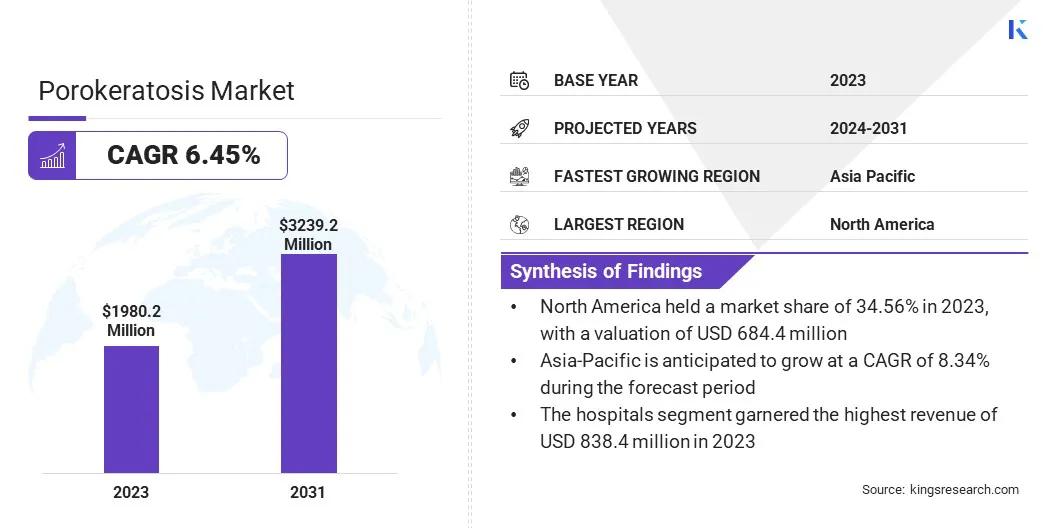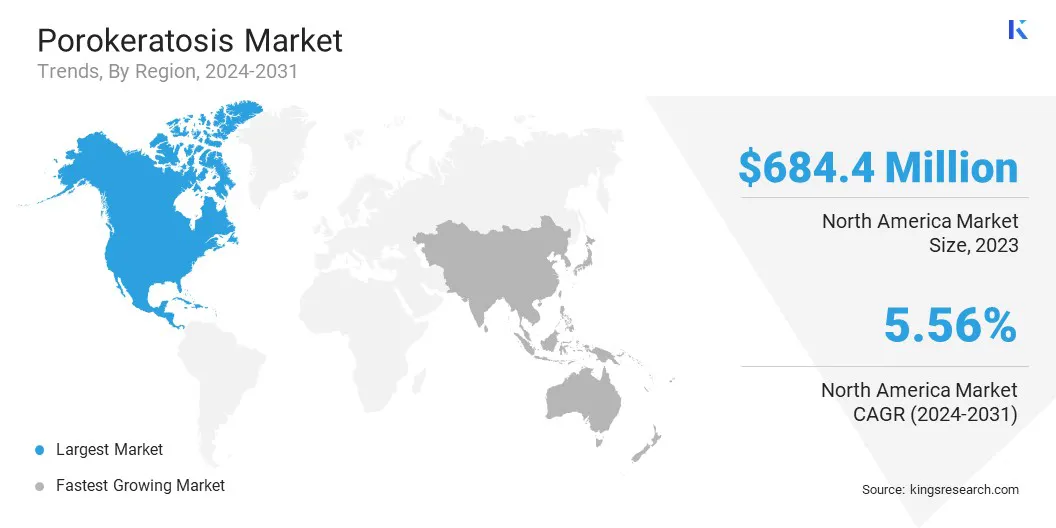Porokeratosis Market Size
The global Porokeratosis Market size was valued at USD 1,980.2 million in 2023 and is projected to grow from USD 2,091.1 million in 2024 to USD 3,239.2 million by 2031, exhibiting a CAGR of 6.45% during the forecast period.
The growing incidence of porokeratosis is prompting increased awareness among both healthcare professionals and patients. As more cases are diagnosed and reported, medical communities are increasingly recognizing the symptoms and variants of this skin condition.
The porokeratosis market is witnessing significant growth, largely attributed to increasing awareness, improved diagnosis rates, and evolving therapeutic approaches. Growing recognition among healthcare professionals and patients is resulting in a surge in the need for effective therapies.
Key Market Highlights:
- Market Value (2023): USD 1980.2 Million.
- Forecasted Value (2031): USD 3239.2 Million.
- CAGR (2024 - 2031): 6.45%.
- The hospitals segment garnered the highest revenue of USD 838.4 million in 2023.
- The physical segment captured the largest porokeratosis market share of 51.43% in 2023.
- North America porokeratosis market share stood around 34.56% in 2023.
- Asia-Pacific is anticipated to witness the highest growth, recording a CAGR of 8.34% over the forecast period.
In the scope of work, the report includes solutions offered by companies such as Allergan (Abbvie), Alma Lasers, Beiersdorf AG, Coherent Corp, Glenmark Pharmaceuticals Ltd., Cutera, Inc., IPG Photonics Corporation, L’Oreal, IRIDEX Corp., Lumenis Be Ltd, and others.

This growing awareness plays a crucial role in ensuring timely diagnosis and treatment, which are essential for managing porokeratosis effectively and improving patient outcomes.
There is a notable shift toward personalized medicine, wherein treatments are tailored based on individual patient characteristics and disease severity. Additionally, the adoption of topical treatments is rising due to their convenience.
Pharmaceutical advancements are enhancing the efficacy of treatment options, thereby supporting market expansion. Despite facing challenges such as underdiagnosis, the market is poised to witness growth as research and development efforts continue to innovate and meet the evolving needs of porokeratosis patients worldwide.
- According to a 2022 article published by the NIH, a study reported that porokeratosis may progress to non-melanoma skin cancer in 6.9-30% of cases.
This highlights the critical need for effective diagnostic and treatment solutions in the market,
Porokeratosis refers to a group of skin disorders characterized by the development of small, raised lesions on the skin. These lesions typically exhibit a ring-like or ridge-like border and may be surrounded by a thin, raised ridge called a cornoid lamella.
Porokeratosis can manifest in various forms, including disseminated superficial actinic porokeratosis (DSAP), linear porokeratosis, and punctate porokeratosis, among others.
The condition is generally considered a disorder of keratinization, where there is abnormal growth and scaling of the skin cells. Porokeratosis can be inherited or acquired and may present with symptoms such as itching, redness, and sensitivity to sunlight.
Analyst’s Review
The expanding range of treatment options is propelling the growth of the porokeratosis market. Cryotherapy is playing a pivotal role in shaping the porokeratosis treatment market landscape by offering a non-invasive and efficient therapeutic option. By utilizing freezing techniques with substances such as liquid nitrogen, cryotherapy targets and eliminates abnormal skin lesions associated with porokeratosis.
This approach is favored for its minimal discomfort, rapid recovery times, and suitability for outpatient settings, thus appealing to both patients and healthcare providers seeking effective treatments. Moreover, key players in the healthcare sector are leveraging laser therapies to manage porokeratosis effectively.
Laser treatments such as fractional lasers and pulsed dye lasers are utilized to precisely target and remove diseased skin cells, thereby improving skin texture and minimizing lesion visibility.
These advanced therapies highlight ongoing innovations in dermatological care, reflecting a commitment to enhancing treatment outcomes and patient satisfaction in managing porokeratosis.
What are the major factors affecting this market?
The porokeratosis market is seeing a boost thanks to increasing awareness among both healthcare professionals and patients. As our understanding of this skin condition improves, we're seeing a significant rise in diagnosis rates. This enhanced recognition is leading to a greater demand for effective treatments that can manage symptoms and improve how patients feel.
- Rising Awareness and Diagnosis: Better understanding of porokeratosis means more people are being diagnosed.
- Increased Demand for Therapies: With more diagnoses, there's a higher need for effective treatments to manage symptoms and improve patient outcomes.
- New Treatment Options: Pharmaceutical companies and healthcare providers are responding to this demand by developing and offering new treatment choices, including topical creams and systemic medications.
- Importance of Education: This trend highlights how crucial education and awareness campaigns are in influencing healthcare decisions and improving overall patient care for dermatological conditions.
What are the major trends in this market?
There's a clear shift in the healthcare sector towards using topical treatments for porokeratosis. This is mainly because they're convenient and non-invasive. Creams and ointments, for example, can be applied directly to the affected skin, offering a localized and easy-to-manage option. Both patients and healthcare providers are finding this approach appealing due to its simplicity and fewer systemic side effects compared to oral treatments.
Plus, improvements in these topical formulas have made them more effective at managing symptoms, further increasing their acceptance. As this continues, we expect the demand for topical treatments to grow, meeting the need for effective and patient-friendly dermatological solutions.
Another emerging trend is personalized medicine for porokeratosis. This approach focuses on creating tailored therapies based on each patient's unique factors and the specific severity of their condition. The goal is to get the best possible treatment outcomes by customizing medical interventions.
- Precise Diagnostics: Personalized medicine involves accurate diagnostics to assess disease severity, genetic factors, and other relevant patient data.
- Targeted Therapies: With this comprehensive understanding, healthcare providers can recommend therapies that are more likely to be effective and well-tolerated by individual patients.
- Enhanced Efficacy and Satisfaction: This trend improves treatment effectiveness and patient satisfaction by addressing individual concerns and preferences. As personalized medicine advances, it's expected to significantly shape the future of porokeratosis treatment by offering solutions that prioritize both effectiveness and patient comfort.
Segmentation Analysis
The global market is segmented based on end-user, treatment type, and geography.
How big is the hospitals segment in this market?
Based on end-user, the porokeratosis market is categorized into hospitals, clinics, homecare settings, and others.
The hospitals segment garnered the highest revenue of USD 838.4 million in 2023, primarily attributable to its provision of advanced diagnostic facilities and specialized dermatological care, which are essential for accurate diagnosis and effective treatment.
Hospitals' participation in research and clinical trials fosters the development of innovative therapies, thereby expanding available treatment options.
Their extensive patient base ensures rapid adoption and dissemination of new treatments, thus promoting segmental expansion.
Additionally, hospitals offer comprehensive care that include continuous monitoring and follow-up services, thereby improving long-term patient outcomes. Through these contributions, hospitals play a crucial role in advancing the porokeratosis treatment market and enhancing patient care and satisfaction.
What is the market share of the physical treatment segment?
Based on treatment type, the market is divided into topical, systemic, and physical. The physical segment captured the largest porokeratosis market share of 51.43% in 2023. Physical treatments include cryotherapy, laser therapy, and photodynamic therapy.
These therapies are highly effective in lesion reduction, providing immediate results and thereby stimulating demand. Technological advancements contribute to enhanced treatment efficacy and safety, thereby attracting increased investment and adoption.
The minimally invasive nature of these treatments, along with their complementary role to other therapies, makes them appealing to both patients and healthcare providers. Increasing accessibility to advanced physical treatment technologies in clinics and hospitals further boosts segmental growth, supporting the expansion of the physical segment.
What is the market scenario in North America and Asia-Pacific region?
Based on region, the global market is classified into North America, Europe, Asia-Pacific, MEA, and Latin America.

What key factors are driving the growth of the porokeratosis market in North America and Asia-Pacific?
North America's Strengths:
- Advanced Healthcare: The region benefits from a highly developed healthcare infrastructure.
- High Awareness: There's a strong level of awareness about porokeratosis among both patients and professionals.
- Research Investment: Significant investments are being made in dermatological research, fostering innovation.
- Leading Companies: The presence of major pharmaceutical and medical device companies helps develop effective treatments.
- Patient Access: Robust healthcare spending and comprehensive insurance coverage ensure more patients can access advanced therapies.
- Early Diagnosis: A strong focus on continuous medical education and the widespread use of cutting-edge diagnostic tools lead to earlier and more accurate diagnoses. These elements collectively boost porokeratosis market growth in North America.
Asia-Pacific's Rapid Ascent:
- Increasing Awareness & Infrastructure: The region is seeing fast growth due to rising awareness and improvements in healthcare infrastructure.
- Growing Access to Care: Increasing healthcare expenditure and an expanding middle-class population mean more people can access dermatological care.
- Emerging Market Opportunities: Countries like China and India present significant opportunities for market expansion, thanks to their large populations and rising demand for advanced medical treatments.
- Enhanced Detection & Management: Increased investments in medical research and development, along with the adoption of advanced diagnostic technologies, improve early detection and effective management of porokeratosis, fueling the Asia-Pacific market's growth.
Market Trend:
North America's Current Dominance: In 2023, North America held a significant share of the global porokeratosis market, around 34.56%, with a valuation of USD 684.4 million, making it the dominant region.
Asia-Pacific's Future Growth: Asia-Pacific is anticipated to experience the highest growth rate, projected to record a Compound Annual Growth Rate (CAGR) of 8.34% over the forecast period.
Competitive Landscape
The global porokeratosis market report will provide valuable insight with an emphasis on the fragmented nature of the industry. Prominent players are focusing on several key business strategies such as partnerships, mergers and acquisitions, product innovations, and joint ventures to expand their product portfolio and increase their market shares across different regions.
Companies are implementing impactful strategic initiatives, such as expanding services, investing in research and development (R&D), establishing new service delivery centers, and optimizing their service delivery processes, which are likely to create new opportunities for market growth.
Key Companies in Porokeratosis Market
- Allergan (AbbVie)
- Alma Lasers
- Beiersdorf AG
- Coherent Corp
- Glenmark Pharmaceuticals Ltd
- Cutera, Inc.
- IPG Photonics Corporation
- L’Oreal
- IRIDEX Corp.
- Lumenis Be Ltd
Key Industry Development
- July 2023:(Product Launch) Alma, a global leader in the energy-based medical and aesthetic solutions industry, announced the commercial availability of Alma Veil. This advanced, dual-wavelength vascular laser workstation set a new standard in excellence, optimizing efficiency and offering remarkable efficacy across a comprehensive range of vascular and dermatological conditions, including porokeratosis. The introduction of Alma Veil has significantly enhanced the treatment options available for porokeratosis, providing a highly effective and precise solution for lesion reduction.
The global porokeratosis market is segmented as:
By End-User
- Hospitals
- Clinics
- Homecare Settings
- Others
By Treatment Type
- Topical
- Systemic
- Physical
By Region
- North America
- Europe
- France
- U.K.
- Spain
- Germany
- Italy
- Russia
- Rest of Europe
- Asia-Pacific
- China
- Japan
- India
- South Korea
- Rest of Asia-Pacific
- Middle East & Africa
- GCC
- North Africa
- South Africa
- Rest of Middle East & Africa
- Latin America
- Brazil
- Argentina
- Rest of Latin America


